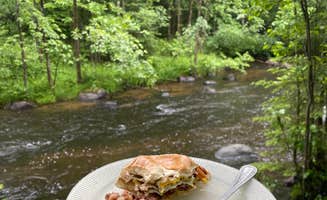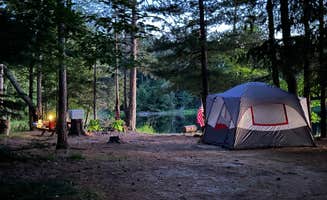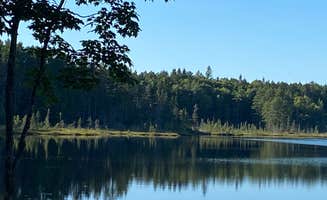Dispersed camping opportunities near Iron Mountain, Michigan extend beyond the Wisconsin border into Michigan's Ottawa National Forest. The forest terrain features rolling hills with mixed hardwood and conifer forests at elevations between 1,200-1,800 feet. Winter camping is possible at select locations, though access may require snowmobiles or specialized vehicles from November through April when snowfall can exceed 100 inches annually.
What to do
Fishing on no-motor lakes: Indian Lake offers a single campsite accessible from a paved road with excellent fishing opportunities. Kay K. mentions, "The campsite is just off a paved road making it easily accessible. It's intended for tents, but a small trailer might fit in the parking area. Many hiking opportunities are nearby."
Swimming and paddling: Sandy beaches provide ideal conditions for water recreation at Woodbury Lake Campsite. According to Kay K., "This remote site has a sandy beach great for swimming or paddling. There is space for a trailer."
Wildlife viewing: The local lakes support diverse wildlife including loons, beavers, and various waterfowl. One camper at Wolf Lake Campsite notes, "The small lake belongs to a pair of loons that will share their fish and sandy beach." Bring binoculars for optimal viewing, particularly during early morning hours.
Winter exploration: For cold-weather enthusiasts, the Hidden Lakes Trail area remains accessible with proper equipment. A winter camper reports, "Winter camped here, was a nice spot pic nik table, fire ring, wilderness toilet. There is hiking trail access from campsite."
What campers like
Lake solitude: Many dispersed sites in this region offer private access to small lakes without crowds. At Three Johns Lake Dispersed, one camper notes it's a "Walk in campsite. Tents only. Short walk to campsite only one on lake. 5 dollar parking national Forest."
Connectivity options: Despite the remote setting, some sites offer limited cellular connectivity. Rebecca B. reports about McCaslin Brook, "There was no AT&T to speak of, but TMobile had 20 down/1 up."
Multiple site options: Some camping areas offer multiple spots to choose from. At Robinson Lake Dispersed Campsite, a camper notes, "Two sites on lake some distance apart. Sand bottom on shore, picknick table and fire ring. No fee for camping can stay 14 days."
Natural beaches: Several sites feature sandy shorelines for easy water access. Hesselinkj@yahoo.com comments about Woodbury Lake, "Nice spot to camp can fit trailer in parking area. There are two picknick tables and fire ring. Tent spot by lake boat access."
What you should know
Road conditions: Forest roads vary dramatically in quality throughout the region. At Bose Lake Campsite, a visitor warns, "Road to get in is narrow and pot holed."
Fee variations: While most sites are free, some require payment. A McCaslin Brook camper explains, "There are 3 sites each with a table, fire pit, a toilet pit and right off the brooke. The cost is $5 a night to be paid at Wheeler Walker Beach."
Site differences: Individual sites have varying capacities and features. At Harriet Lake, "Room for small camper 10to 15 foot also tents wilderness toilet. No motor lake."
Summer dust: Seasonal conditions affect travel comfort. One camper notes about the Hidden Lakes area, "I've been through here in summer and the road is gravel very dusty from traffic."
Tips for camping with families
Swimming beaches: Sites with gradual, sandy entries work best for children. Kay K. recommends Woodbury Lake: "This remote site has a sandy beach great for swimming or paddling."
Vehicle accessibility: Consider sites where you can park close to camping spots with children. At McKinley Lake Dispersed, a camper notes, "A single campsite can park next to tent only. Access to lake."
Wildlife education: Local lakes provide opportunities for wildlife observation and education. A Wolf Lake visitor shares, "The small lake belongs to a pair of loons that will share their fish and sandy beach."
Site selection strategy: With children, prioritize sites away from road noise. About McCaslin Brook, Robyn B. advises, "The third site is a deep, large site away from the road facing west, with a bad easement."
Tips from RVers
Length limitations: Most dispersed sites accommodate only smaller recreational vehicles. At Harriet Lake Campsite, one camper reports, "Room for small camper 10to 15 foot also tents wilderness toilet."
Access challenges: Many entrances have difficult approaches. About McCaslin Brook, hesselinkj@yahoo.com warns, "Entrances need a lot of TLC washed out and large drop from paved road. Middle camp site has best access to brook I put a 8 foot pop up in it you could go bigger 20 foot max."
Site selection for solar: Consider sun exposure for power needs. Rebecca B. notes about McCaslin Brook, "We ultimately decided not to stay here simply because it was so shaded. While that made it nice and cool, it made solar & Starlink impossible."
Winter considerations: Some sites remain accessible year-round with proper equipment. A winter camper at Hidden Lakes Trail mentions, "Winter camped here, was a nice spot... Did get one bar of cell (cricket) full with 20 foot ant."




